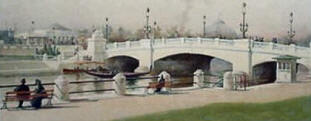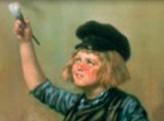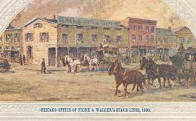GOOD ART IN HIGH
CLASS MOVIE FILM
Local Landscape and Portrait Painter
Tells Why He Likes Motion Pictures
PROVIDE HIM WITH IDEAS
(By Mary E. Remington.)
"Why does an artist go to the movies?"
A "movie fan" put this question squarely to Lawrence C.
Earle, the well known portrait and landscape artist. Mr. Earle won much
distinction in New York and the east building up a substantial
reputation in the art centers of America before returning to Grand
Rapids, his native city.
The question was inspired by the fact that there is no
more consistent patron of the Majestic Gardens than Mr. Earle. "Now
confess," persisted the movie fan, "what can a real artist possibly find
in anything so plebeian as a reel show? Is it not the general
supposition that the 'high brow' artists of the brush and palette scorn
the movies?"
"It is a very foolish supposition," replied Mr. Earle.
"There is more good art in the high class motion pictures than is
popularly credited to them. I find valuable ideas and suggestions in the
way of subjects, composition, lighting and other art qualities which are
often admirably exemplified in the motion pictures. Some of them are
very bad, I grant, but I find in many of the pictures certain art
qualities which are well worth studying."
As a recent example of this Mr. Earle mentioned "The
Daughter of MacGregor," calling attention especially to the Scotch
scenes depicted in the production. "The picture of the old Scotchman."
he said, "seated at the desk table reading his Bible was such an
admirable portrait study that I would like to have painted him just as
he was shown in the picture. There were one or two other fine old
characters in this production worthy of any artist's brush.
Variety Is Infinite.
"Many of the picture productions show exceedingly fine
scenic backgrounds photographed directly from nature and it is the
almost infinite variety of the sort of thing that gives a special
interest to the pictures. Undoubtedly many of the men who direct the
productions either have natural art instincts or are familiar with the
art of selection, arrangement, perspective, lighting and other qualities
that go into the making of an artistic composition.
"The amazing fact about the cinematograph is not that
there are so many poor productions, but that in the short span of its
existence the pictures should have developed so much that is admirable
and frequently very fine. The motion picture production is still in its
infancy, and it has possibilities of becoming an effective art
medium. I am watching the development with a great deal of interest.
Public taste and patronage will be a powerful factor in determining the
future of the motion picture, and therefore I consider it far more
sensible to consider the subject from a constructive viewpoint, to
recognize and appreciate whatever is good in the picture, and to
encourage whatever makes for their betterment, than to denounce the
whole enterprise because much of it is cheap and inferior.
"One thing is certain, the motion picture is here to
stay - it is a permanent fixture and what it needs is not wholesale
condemnation, but the encouragement of all that is good, and whatever
makes for its highest and best development."
GRAND RAPIDS PRESS, FRIDAY, OCTOBER
13, 1916; p.8



